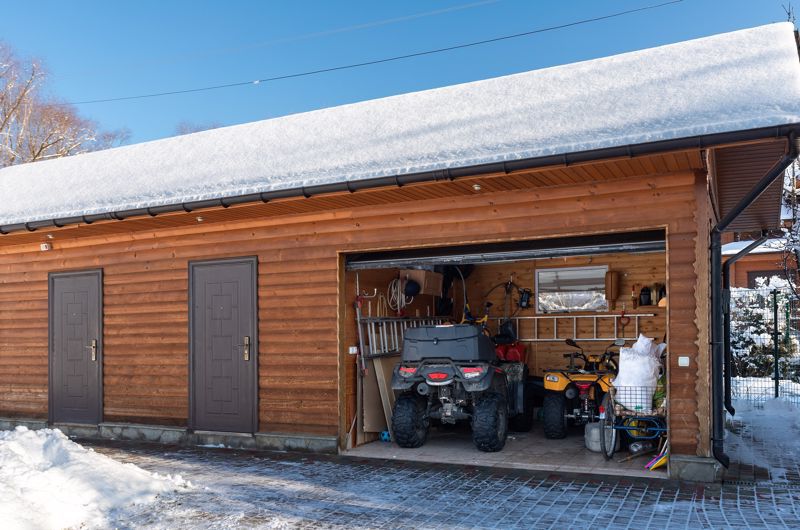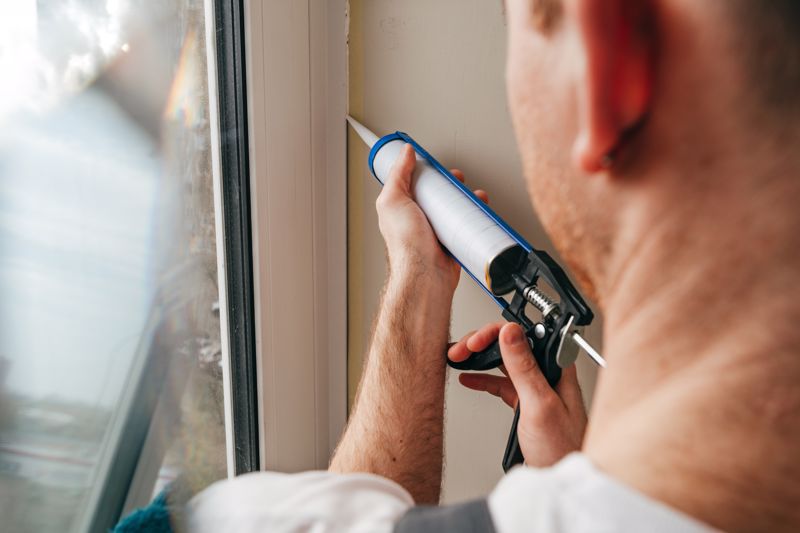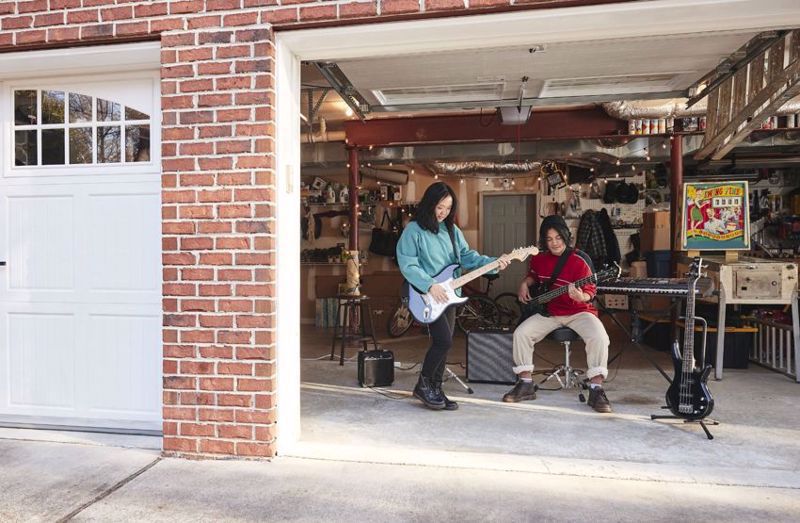10 Tips To Keep Your Garage Warm This Winter
- Oct 22, 2024
- Seasonal Tips
- 9 minute read

If you live somewhere with cold or even cool winters, then you know how unpleasant a chilly garage is. How nice would it be if your garage could just stay warm all winter? But keeping your garage warm isn't just about comfort — it's about protecting your belongings and making the space usable year-round.
Retaining heat in your garage can have significant benefits that go far beyond keeping your feet warm when you take out the recycling. And there are relatively easy things you can do to enjoy these benefits. Using these fixes and upgrades, you can transform your garage into a cozy, functional area even in the coldest months.

The smallest to largest garages can be upgraded to ensure they're warm through winter.
Why It's Important to Keep Your Garage Warm?
The importance of garage heating and retaining warmth varies depending on your location. For most people in the U.S., the garage can be pretty chilly come January. Whether the winter is just a little crisp or positively frigid where you live, it's worth looking into ways to make your garage a little warmer.
If you keep one or more vehicles in your garage, shielding them from the coldest temperatures is a very real benefit. Car batteries and engines can really suffer in winter, and an even slightly warmer garage can be the difference between an easy start to your day and needing to replace or jump-start your battery.
If your garage is attached to your home, then you can enjoy serious energy savings with a warmer garage. This may seem counterintuitive if you're using a garage heater, but something like an insulated garage door can decrease heat loss in your home. This means you may not have to spend as much on heating throughout the winter.
And then there's comfort. Comfort matters, whether you're in your garage for a minute or an hour. If you use your garage for any handyperson projects or arts and crafts, keeping your garage warm is definitely worthwhile.
10 Ways To Keep the Cold Winter Air out of Your Garage
A warm garage in winter is great, but how do you achieve this? It may be easier than you think. Here's how to keep your garage warm in winter:
1. Seal Cracks and Gaps
Taking a few hours one fall afternoon can mean a real difference in the temperature of your garage come winter. Many garages have the odd crack and gap somewhere that allows the warm air out and the cold air in. Blocking these gaps is a cheap and relatively easy way to keep your garage warmer. Consider three main options:
- Weatherstripping: Installing weatherstripping around windows and doors is an effective way to prevent drafts.
- Caulking: Use caulk to seal any cracks or gaps around windows, door frames and the garage floor.
- Insulate outlets: Add foam gaskets behind the outlet and switch plates on exterior walls.

Caulking around windows, doors and the garage floor helps seal in the warmth.
2. Insulate Walls and Ceiling
Presumably, your home is insulated — so why not your garage? Insulation is especially beneficial if your garage is attached to your house. An uninsulated, attached garage allows heat from your home to dissipate into the winter air. Insulated garages keep more of that warmth in your home. Consider these two areas for insulation:
- Wall insulation: If your garage walls aren't insulated, consider adding fiberglass batt insulation or foam board insulation between the studs. While a bit more involved than caulking cracks and gaps, adding insulation can make a big difference to garage temperatures. They can also help in summer, meaning you don't have to spend as much on air conditioning.
- Ceiling insulation: Insulate the ceiling if your garage is below a living space to prevent heat loss from above. Ceiling insulation isn't as critical if there's nothing above your garage, but it can still help keep it warm.
3. Purchase an Insulated Garage Door
Insulating garage walls is a great idea, but if that's all you insulate, you're missing a large part of your garage. For most garages, the garage door is pretty much the entire front side of the structure. That means if you only insulate the walls, you're only insulating three of your garage's four sides.
Garage door insulation would complete the project. This can drastically improve the temperature in the garage. So, if you're ready to invest, consider replacing your current garage door with an insulated model.

The Classica model comes with polyurethane or polystyrene insulation, so you and your family can jam in your garage no matter the season.
Learn more about garage door construction.
4. Install Insulated Windows
Your garage door and walls are key areas to insulate because they comprise most of the surface area of your garage. However, if your garage has windows, consider insulating those, as well. Even though they're comparatively small, garage windows can also be problem areas for heat loss. If you're not satisfied with weatherstripping and caulking, insulated windows can really up your insulation game. Consider these options:
- Double-pane windows: Consider replacing single-pane windows with double-pane ones. The extra pane can significantly improve insulation.
- Window insulation film: Depending on your type of garage windows, insulation film may be a more practical option. Applying window insulation film to existing windows can reduce drafts.
5. Cover the Floor
We've discussed garage doors, walls, ceilings and windows. There's one only side of the garage left: the floor. Depending on the type of garage floor you have and what you use it for, your floor coverage options will be different. Between rugs, mats and epoxy coating, though, you have several options that may help keep the cold air from rising from the ground. Consider these options:
- Rugs and mats: Laying down thick rugs or rubber mats on the garage floor to provide insulation and reduce heat loss through the concrete. These options may not be practical if you drive in and out of your garage every day, but there may be areas of your garage floor on which you can lay down rugs. Covering even part of your garage floor can make a difference.
- Epoxy coating: Applying an epoxy coating to the garage floor can help seal it and reduce cold air from seeping into the space.
6. Use a Space Heater
So far, we've looked at ways to keep cold air out and warm air in. But you can also generate heat. A space heater is a tried and tested way to warm small spaces. A space heater is a relatively cheap option, and setting one up is as easy as can be. However, you may want to consider your insulation options first. A garage heater will keep the space warm, but without an insulated garage door, a lot of that heat will escape. Remember though, a heater will probably increase your energy usage, and therefore, your monthly bill.
One key consideration for space heaters is safety. You want to choose a model of heater suitable for garage use. It's worth spending the time and effort necessary to research which garage heater option is safest and most practical for you. Also, please follow all safety guidelines. If you are going to lay rugs down on your garage floor, for example, be wary of a possible fire hazard with the space heater. Also, be careful not to store any flammable materials or solvents — or gasoline — near the space heater.
7. Use Draft Stoppers
Draft stoppers can be a moveable yet effective method for retaining warm air in your garage. Install a door sweep or use a draft stopper at the bottom of the garage door to keep cold air from entering. There are options you can move in and out of place as you leave and park in your garage. You can remove the stopper in the morning when you go to work and put it back in place in the evening, helping to keep out the frosty night air during winter.
8. Install a Ceiling Fan
We typically think of fans as a summertime tool to cool ourselves down. But ceiling fans can help distribute warm air more evenly in a room during the winter. Many ceiling fans have a switch that changes the direction of the blades. In the winter, set the fan to rotate clockwise at a low speed.
This reverse direction pulls cool air up and pushes the warm air, which naturally rises to the ceiling, down along the walls and back into the room. This gentle redistribution of warm air helps maintain a more consistent temperature throughout the space, reducing the need for additional heating. A ceiling fan also uses less energy than a space heater.
9. Consider a Doorway Vestibule
A doorway vestibule is an innovative way to keep your garage warm. You can build a permanent or temporary vestibule.
You've probably seen vestibules like this at the entrances of restaurants, bars or shops. Businesses often install temporary vestibules during winter. A doorway vestibule with a second layer of plastic sheeting or heavy curtains can create an air barrier between the garage and the outdoors.
If you're up for a home improvement project, consider building a permanent vestibule. A permanent vestibule has to be sturdier than a temporary one, but then you won't have to build a new one each year. And it can help keep hot air out during summer.
10. Cover Exposed Pipes
Insulate any exposed water pipes in the garage to prevent heat loss and protect them from freezing. Frozen pipes can burst, causing no small amount of damage.
Enjoy a Warm Winter With an Insulated Garage Door
Garages have so much forgotten potential — especially during the cold winter months. By making your space warmer, you can enjoy your garage no matter the season. Whether your garage houses your workbench where you carry out your hobbies or you just want extra space to hang out with friends, a warm garage can be an inviting, comfortable atmosphere.
To create the warmest garage possible — and maximize your energy savings — install a beautiful, insulated garage door. Curious about how your new garage door will look? Use our door designer tool below to get started.

